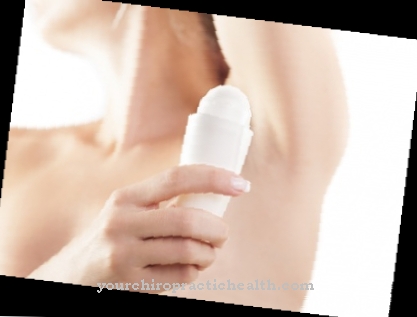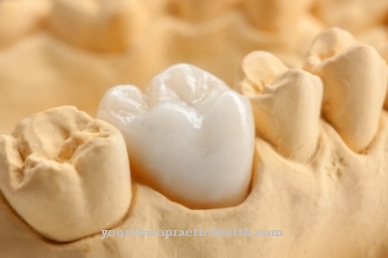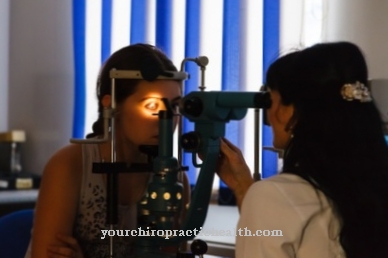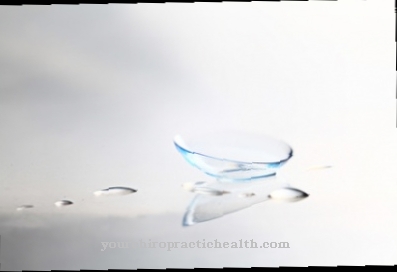Adhesive strips are there to give the denture a better hold. Other proven prosthesis adhesives are also prosthesis adhesives, adhesive creams, adhesive gels or adhesive powder. Prosthesis wearers usually find the products pleasant because the artificial teeth sit more firmly and do not rub against the gums.
What are adhesive strips?

An adhesive strip is a special adhesive that holds the denture in place. Because if the prosthesis is not, or is only insufficiently secured, it can loosen. This mainly happens when eating, drinking or speaking.It usually happens with full dentures because, unlike partial dentures, they no longer have any anchoring in the mouth.
In the upper jaw, the prosthesis usually does not cause any problems. She's sucking on the jaw there. It is different with the lower jaw. Leverage can be seen here, because the tongue and the jaw muscles have to do their job. In most cases, there are also unfavorable jaw conditions.
When the alveolar process has shrunk, an adhesive strip is essential. Especially for older prosthesis wearers, an adhesive strip can provide significant relief, because the production of saliva decreases with age and the patients are no longer supplied with viscous saliva. With new prostheses, the use of adhesive strokes can also be useful, as it facilitates the familiarization phase for the wearer.
Shapes, types & types
There are many types of adhesives, all of which hold the prosthesis in place. Adhesive creams are mostly used, they are offered with and without zinc. Zinc has an anti-inflammatory effect, can accelerate wound healing and relieve pain in the gums.
The prosthesis adheres firmly to the palate thanks to the strips; even if the natural saliva production is no longer sufficient. A film forms between the artificial teeth and the gums / palate, which increases the attachment force. Even if the prosthesis no longer fits the gums exactly and cavities develop, these are compensated for by the adhesive strips. This applies to all prosthesis adhesives, i.e. adhesive strips, adhesive creams, adhesive gel or adhesive cushions.
Many drugs are offered in pharmacies or drugstores, mostly as liquids or ointments. Adhesive cushions are also a very popular variant, they are foils made of plastic and stretchable. The body heat then makes the material soft and supple. The adhesive cushions attach to the jaw and can last up to three weeks. For daily cleaning, only the prosthesis is taken out of the mouth, the adhesive cushions stick.
The adhesive strips, which are made of fine fleece fabric and sodium alginate, offer a completely different adhesive. They can be used in the upper jaw and also in the lower jaw and are easy to use in the form of a dental prosthesis. They are placed on the moistened prosthesis and hold the teeth in place.
Structure & functionality
The exact composition of prosthesis adhesives is not fully known as manufacturers withhold information. A wide variety of adhesives are used, which are sodium alginate, methyl cellulose or carboxymethyl cellulose. The adhesive can also be made with a mixture of calcium-sodium salts, maleic anhydride and methyl vinyl ether.
It can also contain zinc, aloe vera, menthol, petrolatum, azorubine, cellobiose, paraffin or silicon dioxide. Methyl cellulose is used very often. This substance works quickly and has a long-term effect. However, a basic requirement for a well-fitting dental prosthesis is a good dentist, because no glue can compensate for defects in the prosthesis.
The adhesive creams or adhesive strips ensure that the oral mucus thickens and becomes more tougher. The dentures must be carefully cleaned before insertion, the adhesive strip then holds the denture in place. Adhesive powder is suitable for the upper jaw, while adhesive creams or adhesive strips are more suitable for the lower jaw.
Applying the prosthesis adhesive is very easy. It is brought into the mouth with the denture and pressed firmly into place. However, it is advisable to allow some time to pass before the next meal. Of course, the dentures must be cleaned daily and the residues of the adhesive cream removed. The products should not be used in excess, as the adhesive effect then wears off.
You can find your medication here
➔ Medicines against tartar and tooth discolorationMedical & health benefits
Prosthesis adhesives ensure a better wearing comfort and increase the acceptance of a full denture. The movements of the prosthesis are reduced, which also reduces pressure points and sores on the gums. In addition, the gums are padded, which in turn is perceived as pleasant.
The strong hold enables you to bite firmly again. Food scraps cannot easily get under the denture either, as the edge of the denture is almost sealed. The prosthesis sits firmly, which means that the wearer also gains more self-confidence. He doesn't have to worry about the dentures falling out of his mouth. He can laugh, speak and eat without any problems.
Various studies show that the adhesives improve the wearing of prostheses. Of course, the dentures must be very well adapted to the individual mouth. Irritation and pressure points are permanently avoided and the prostheses can be worn without interference.
It is safe to use adhesive strips and the like. It is only important that the teeth are really cared for and that germs cannot damage your health. By regularly changing the adhesive and cleaning the dentures, however, care is sufficient.

























.jpg)


